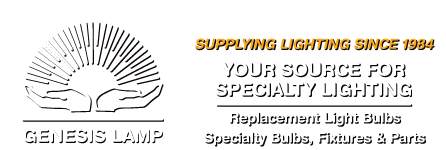Light Bulb Bases
There are two main types of light bulb bases. Screw bases and pin bases. Each works to connect the light bulb to the electrical voltage to light the bulb.
Screw Base Light Bulbs
Screw bases are a common light bulb base. In a halogen or incandescent screw base light bulb, two contact wires connect the filament to the base of the light bulb where the electrical voltage connects to the bulb. The contact wires are soldered to the base at two different points on the base in order to keep them affixed to the metal base.
The candelabra E12 has a diameter of 12 millimeters.
The “E” in the light bulb size refers to Edison, the inventor of the screw base light bulb, and screw base light bulbs are sometimes called “Edison light bulbs.” Candelabra bases are mostly used in smaller, decorative incandescent, CFL, and CCFL light bulbs.
The intermediate E17 base is not common. It is found on smaller light bulb shapes - S11, R12, and T6 bulbs.
The medium E26 base is a common light bulb base. It is used in most incandescent, halogen, CCFL, CFL and HID light bulbs.
The mogul E39 base is found in larger sized light bulbs, such as high wattage HID.

The mogul pre-focused (MPF) base is similar to the screw base in that it connects the filament to the base with two soldered contact wires; however, MPF bases do not screw into the socket. Rather, the base metal has a smooth edge, and the base is pushed into the socket and then turned to lock it into place.
The bayonet base is a smaller fail-safe light bulb base.
The wedge base is found in incandescent T3.25 light bulbs.
Pin Base Light Bulbs
Pin bases are used in MR16 bulbs, linear fluorescent bulbs, plug-in compact fluorescent bulbs, and a few HID light bulbs.
